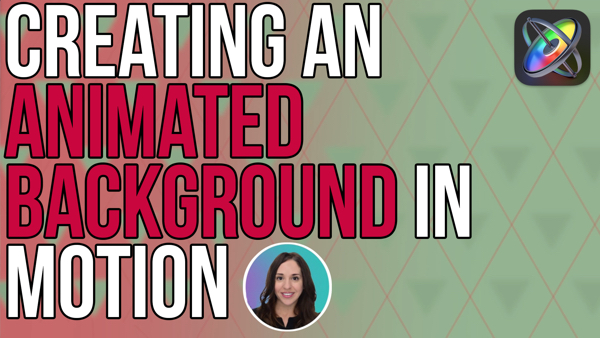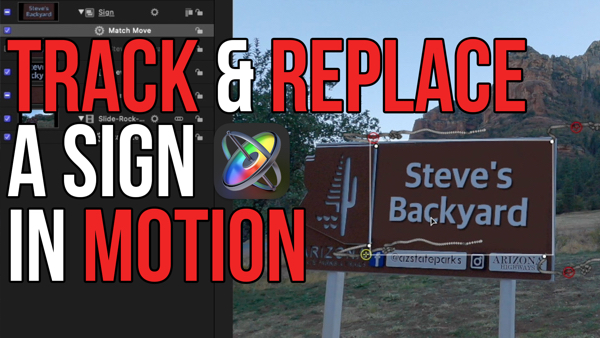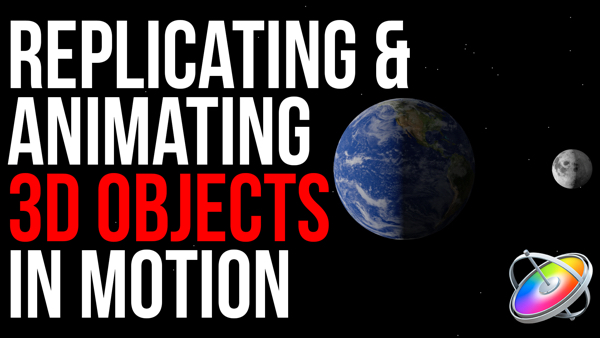How to Create Exploding Text
In “Under 5 Minutes” Mark Spencer will teach you how to make an exploding text effect in Apple’s Motion 5.
This 3D effect is created easily using Motion’s Sequence Text behavior tool and modifying spread, speed, and rotation.
In this episode, I’ll show you how to create this 3D exploding text effect. You can download the project file by using the link in the Description below.
I’m Mark Spencer from RippleTraining.com. Welcome to Motion Magic where you’ll learn visual effects and motion graphics in under 5 minutes.
Here I am in Motion with a new empty project.
First, I’ll select the Text tool, click in the Canvas, and type my text.
I’ll press the Escape key, then use the Heads-Up-Display to format the text.
In the Properties Inspector, I’ll press the top hooked arrow to reset the Transform parameters, which centers the text.
To animate the letters, I’ll click the Behaviors shortcut menu and select Text Animation > Sequence Text.
As we can see in the Toolbar, this action automatically switches the current tool to the Adjust Item Tool.
In the Canvas, I’ll use the arrows to drag the first letter up, over, and forward in Z-space. I’ll also use the rotation circles to rotate the characters on all three axes.
In the HUD, I’ll change the Sequencing to To, the Spread to 100, the Speed to Decelerate, and the Position Type to Relative.
We don’t want an immediate explosion, so I’ll move the playhead forward 1 second and press I to trim the behavior’s In-point.
And we want a fast explosion, so I’ll move the playhead forward another second and press O to trim the behavior’s Out-point. The text needs to end here as well so I’ll select it in the Layers list and press O to trim it as well. Then I’ll drag the Play Range Out Point to create a short play range around this animation.
If I play the play range now, all the letters animate exactly the same way. So with the playhead at the end of the animation, I’ll reselect the behavior in the Layers list, the in the Behaviors Inspector, I’ll open the Variance section and increase the Variance parameter to 100% and Noisiness to 1. At the top of the Behaviors Inspector, I can adjust the changes I made to position and rotation earlier.
I’ll also make the characters fade out by clicking the Add pop-up menu, selecting Format > Opacity, and setting the Opacity value to 0.
If I play that back now, every character flys off in random directions.
To see that this is happening in 3D space, I can add a camera, click Switch to 3D, then use the Orbit tool to orbit the camera and scrub the animation. Ok, I’ll double-click the Orbit tool to reset the camera.
To add the explosion, I’ll move the playhead to the start of the animation, then in the Library, in Particles Emitters, in the Pyro folder, I’ll locate Explosion and drag it to the group.
If I scrub the timeline, I can see it’s way too small, so I’ll grab a corner, hold down Shift and Option, and drag to scale it up.
Then I’ll play the play range and adjust the timing of the explosion as needed.
As an extra touch, I can select the text and use the Filters shortcut menu to select Stylize > Extrude to add some depth to the text, which I can adjust in the Canvas. I just use a little, because it’s not a true 3D effect.
Finally, I’ve used Final Cut Pro X’s Music and Sound Browser to locate an explosion sound, which I copied to a folder. I’ll move the playhead to the start of the explosion, go to the File Browser, locate the sound effect, and drag it to the Layers List. I can then play and adjust the timing as needed.
Click the Subscribe button below. If you have an idea, comment or suggestion, leave those below as well. Go to RippleTraining.com for fast professional training on Final Cut Pro, Motion and DaVinci Resolve from industry professionals.
I’m Mark Spencer from RippleTraining.com. Welcome to Motion Magic where you’ll learn visual effects and motion graphics in under 5 minutes.
Here I am in Motion with a new empty project.
First, I’ll select the Text tool, click in the Canvas, and type my text.
I’ll press the Escape key, then use the Heads-Up-Display to format the text.
In the Properties Inspector, I’ll press the top hooked arrow to reset the Transform parameters, which centers the text.
To animate the letters, I’ll click the Behaviors shortcut menu and select Text Animation > Sequence Text.
As we can see in the Toolbar, this action automatically switches the current tool to the Adjust Item Tool.
In the Canvas, I’ll use the arrows to drag the first letter up, over, and forward in Z-space. I’ll also use the rotation circles to rotate the characters on all three axes.
In the HUD, I’ll change the Sequencing to To, the Spread to 100, the Speed to Decelerate, and the Position Type to Relative.
We don’t want an immediate explosion, so I’ll move the playhead forward 1 second and press I to trim the behavior’s In-point.
And we want a fast explosion, so I’ll move the playhead forward another second and press O to trim the behavior’s Out-point. The text needs to end here as well so I’ll select it in the Layers list and press O to trim it as well. Then I’ll drag the Play Range Out Point to create a short play range around this animation.
If I play the play range now, all the letters animate exactly the same way. So with the playhead at the end of the animation, I’ll reselect the behavior in the Layers list, the in the Behaviors Inspector, I’ll open the Variance section and increase the Variance parameter to 100% and Noisiness to 1. At the top of the Behaviors Inspector, I can adjust the changes I made to position and rotation earlier.
I’ll also make the characters fade out by clicking the Add pop-up menu, selecting Format > Opacity, and setting the Opacity value to 0.
If I play that back now, every character flys off in random directions.
To see that this is happening in 3D space, I can add a camera, click Switch to 3D, then use the Orbit tool to orbit the camera and scrub the animation. Ok, I’ll double-click the Orbit tool to reset the camera.
To add the explosion, I’ll move the playhead to the start of the animation, then in the Library, in Particles Emitters, in the Pyro folder, I’ll locate Explosion and drag it to the group.
If I scrub the timeline, I can see it’s way too small, so I’ll grab a corner, hold down Shift and Option, and drag to scale it up.
Then I’ll play the play range and adjust the timing of the explosion as needed.
As an extra touch, I can select the text and use the Filters shortcut menu to select Stylize > Extrude to add some depth to the text, which I can adjust in the Canvas. I just use a little, because it’s not a true 3D effect.
Finally, I’ve used Final Cut Pro X’s Music and Sound Browser to locate an explosion sound, which I copied to a folder. I’ll move the playhead to the start of the explosion, go to the File Browser, locate the sound effect, and drag it to the Layers List. I can then play and adjust the timing as needed.
Click the Subscribe button below. If you have an idea, comment or suggestion, leave those below as well. Go to RippleTraining.com for fast professional training on Final Cut Pro, Motion and DaVinci Resolve from industry professionals.




